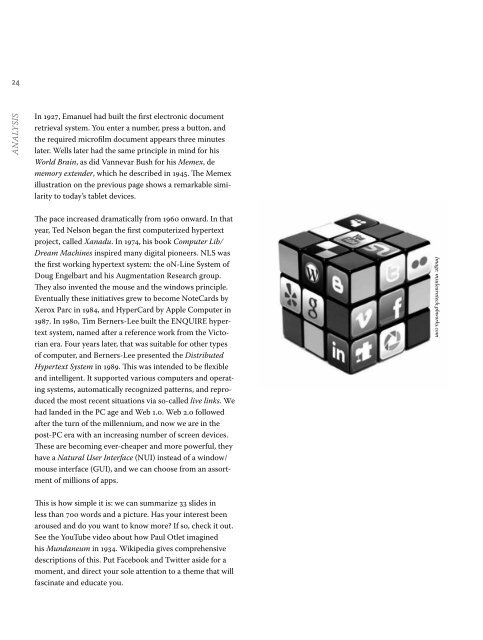VINT-The-Dark-Side-of-Social-Media-Alarm-Bells-Analysis-and-the-Way-Out
VINT-The-Dark-Side-of-Social-Media-Alarm-Bells-Analysis-and-the-Way-Out
VINT-The-Dark-Side-of-Social-Media-Alarm-Bells-Analysis-and-the-Way-Out
Create successful ePaper yourself
Turn your PDF publications into a flip-book with our unique Google optimized e-Paper software.
24<br />
aNalYSiS<br />
In 1927, Emanuel had built <strong>the</strong> first electronic document<br />
retrieval system. You enter a number, press a button, <strong>and</strong><br />
<strong>the</strong> required micr<strong>of</strong>ilm document appears three minutes<br />
later. Wells later had <strong>the</strong> same principle in mind for his<br />
World Brain, as did Vannevar Bush for his Memex, de<br />
memory extender, which he described in 1945. <strong>The</strong> Memex<br />
illustration on <strong>the</strong> previous page shows a remarkable similarity<br />
to today’s tablet devices.<br />
<strong>The</strong> pace increased dramatically from 1960 onward. In that<br />
year, Ted Nelson began <strong>the</strong> first computerized hypertext<br />
project, called Xanadu. In 1974, his book Computer Lib/<br />
Dream Machines inspired many digital pioneers. NLS was<br />
<strong>the</strong> first working hypertext system: <strong>the</strong> oN-Line System <strong>of</strong><br />
Doug Engelbart <strong>and</strong> his Augmentation Research group.<br />
<strong>The</strong>y also invented <strong>the</strong> mouse <strong>and</strong> <strong>the</strong> windows principle.<br />
Eventually <strong>the</strong>se initiatives grew to become NoteCards by<br />
Xerox Parc in 1984, <strong>and</strong> HyperCard by Apple Computer in<br />
1987. In 1980, Tim Berners-Lee built <strong>the</strong> ENQUIRE hypertext<br />
system, named after a reference work from <strong>the</strong> Victorian<br />
era. Four years later, that was suitable for o<strong>the</strong>r types<br />
<strong>of</strong> computer, <strong>and</strong> Berners-Lee presented <strong>the</strong> Distributed<br />
Hypertext System in 1989. This was intended to be flexible<br />
<strong>and</strong> intelligent. It supported various computers <strong>and</strong> operating<br />
systems, automatically recognized patterns, <strong>and</strong> reproduced<br />
<strong>the</strong> most recent situations via so-called live links. We<br />
had l<strong>and</strong>ed in <strong>the</strong> PC age <strong>and</strong> Web 1.0. Web 2.0 followed<br />
after <strong>the</strong> turn <strong>of</strong> <strong>the</strong> millennium, <strong>and</strong> now we are in <strong>the</strong><br />
post-PC era with an increasing number <strong>of</strong> screen devices.<br />
<strong>The</strong>se are becoming ever-cheaper <strong>and</strong> more powerful, <strong>the</strong>y<br />
have a Natural User Interface (NUI) instead <strong>of</strong> a window/<br />
mouse interface (GUI), <strong>and</strong> we can choose from an assortment<br />
<strong>of</strong> millions <strong>of</strong> apps.<br />
This is how simple it is: we can summarize 33 slides in<br />
less than 700 words <strong>and</strong> a picture. Has your interest been<br />
aroused <strong>and</strong> do you want to know more? If so, check it out.<br />
See <strong>the</strong> YouTube video about how Paul Otlet imagined<br />
his Mundaneum in 1934. Wikipedia gives comprehensive<br />
descriptions <strong>of</strong> this. Put Facebook <strong>and</strong> Twitter aside for a<br />
moment, <strong>and</strong> direct your sole attention to a <strong>the</strong>me that will<br />
fascinate <strong>and</strong> educate you.<br />
Image: msulearntech.pbworks.com


